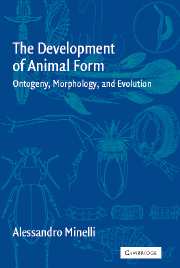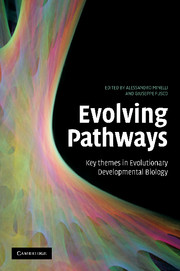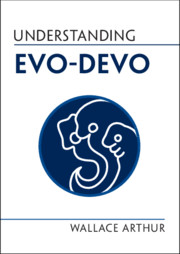The Origin of Animal Body Plans
A Study in Evolutionary Developmental Biology
£42.99
- Author: Wallace Arthur, University of Sunderland
- Date Published: November 2000
- availability: Available
- format: Paperback
- isbn: 9780521779289
£
42.99
Paperback
Other available formats:
Hardback
Looking for an inspection copy?
This title is not currently available on inspection
-
Neo-Darwinism currently occupies a dominant position in evolutionary thought. While this theory has considerable explanatory power, it is widely recognized as being incomplete in that it lacks a component dealing with individual development, or ontogeny. This is particularly conspicuous in relation to attempts to explain the evolutionary origin of the 35 or so animal body plans, and of the developmental trajectories that generate them. This book examines both the origin of body plans in particular and the evolution of animal development in general. In doing so, it ranges widely, covering topics as diverse as comparative developmental genetics, selection theory and Vendian/Cambrian fossils. Particular emphasis is placed on gene duplication, changes in spatio-temporal gene-expression patterns, internal selection, coevolution of interacting genes, and coadaptation. The book will be of particular interest to students and researchers in evolutionary biology, genetics, paleontology and developmental biology.
Read more- There is currently no other book devoted to exploring possible evolutionary mechanisms underlying the origin of animal body plans
- The book covers all biological levels of organization - from molecules and cells through organisms and populations to lineages and clades
- The book takes a novel view of how natural selection modifies the genetic architecture of development: there is a particular emphasis on the concept of internal selection
Reviews & endorsements
'… useful and thought provoking.' Michael K. Richardson, Heredity
See more reviews'I strongly recommend it to anyone with an interest in where evolutionary biology is going next.' John A. Lee, Biologist
'… an interesting and intelligent book.' Anthony Graham, BSDB Newsletter
' … a readable and enjoyable account of the current state of developmental genetics.' BioEssays
Customer reviews
Not yet reviewed
Be the first to review
Review was not posted due to profanity
×Product details
- Date Published: November 2000
- format: Paperback
- isbn: 9780521779289
- length: 360 pages
- dimensions: 255 x 179 x 19 mm
- weight: 0.646kg
- contains: 85 b/w illus. 17 tables
- availability: Available
Table of Contents
Preface
Acknowledgements
Part I. Introduction:
1.1 A developmental approach to an evolutionary problem
1.2 The early history of the animal kingdom
1.3 Alternative strategies
1.4 Creation versus destruction
1.5 Systematics and the concept of natural classification
1.6 Micromutation versus macromutation
1.7 Developing organisms as inverted cones
Part II. What is a Body Plan?:
2.1 Body plans and taxonomic levels
2.2 Body plans, cladograms and homology
2.3 Body plans and embryology
2.4 Body plans, genes and mutations
2.5 Body plans, adaptation and environments
Part III. Patterns of Body Plan Origins:
3.1 Strategy
3.2 Patterns of metazoan inter-relationships
3.3 Early fossils: from cladograms to trees
3.4 Bringing back morphology
3.5 Paleoecology and possible adaptive scenarios
Part IV. Evolutionary Developmental Biology:
4.1 From pattern to mechanism
4.2 The aims of Evolutionary Developmental Biology
4.3 A brief history
4.4 Is there a theory of development?
Part V. Developmental Mechanisms: Cells and Signals:
5.1 Strategy
5.2 Cellular processes and architecture
5.3 Short-range signals: cell-cell contacts
5.4 Mid-range signals and the nature of 'morphogens'
5.5 Long-range signals and pan-organismic co-ordination
5.6 Patterns of interconnection: developmental programmes
Part VI. Developmental Mechanisms: Genes:
6.1 Introduction
6.2 Overview of the genetics of Drosophila body axes
6.3 The Antennapedia and Bithorax complexes
6.4 The hedgehog gene and limb development
6.5 Developmental programmes and an evolutionary message
Part VII. Comparative Developmental Genetics:
7.1 From development to evolution
7.2 Phylogeny of Hox genes
7.3 Dorso-ventral polarity in arthropods and chordates
7.4 Limb formation, hedgehog, and the nature of homology
7.5 Phylogeny of cadherin genes
7.6 Emergent evolutionary messages
Part VIII. Gene Duplication and Mutation:
8.1 Introduction
8.2 The creation of new genes
8.3 Mutation: the classical approach
8.4 Mutation: a developmental approach
8.5 Mutation and the evolution of development
Part IX. The Spread of Variant Ontogenies in Populations:
9.1 Introduction
9.2 Population genetic models of directional selection
9.3 Internal selection
9.4 The origin of body plans: a population perspective
9.5 Types of genetic change
9.6 Drift, drive and directed mutation
Part X. Creation Versus Destruction:
10.1 A fourth 'eternal metaphor'?
10.2 Mutationists v. selectionists: a protracted debate
10.3 The structure of morphospace
10.4 Creation and destruction
Part XI. Ontogeny and Phylogeny Re-Visited:
11.1 Mapping the two hierarchies
11.2 From two hierarchies to six
11.3 An important general pattern
11.4 Larval forms and complex life histories
11.5 Phenotypic complexity and evolutionary 'explosions'
Part XII. Prospect: Expanding the Synthesis:
12.1 Neither boredom nor heresy
12.2 Completing the evolutionary circle
12.3 The main themes of Evolutionary Developmental Biology
12.4 Paths into the future
References
Index.
Sorry, this resource is locked
Please register or sign in to request access. If you are having problems accessing these resources please email [email protected]
Register Sign in» Proceed
You are now leaving the Cambridge University Press website. Your eBook purchase and download will be completed by our partner www.ebooks.com. Please see the permission section of the www.ebooks.com catalogue page for details of the print & copy limits on our eBooks.
Continue ×Are you sure you want to delete your account?
This cannot be undone.
Thank you for your feedback which will help us improve our service.
If you requested a response, we will make sure to get back to you shortly.
×







